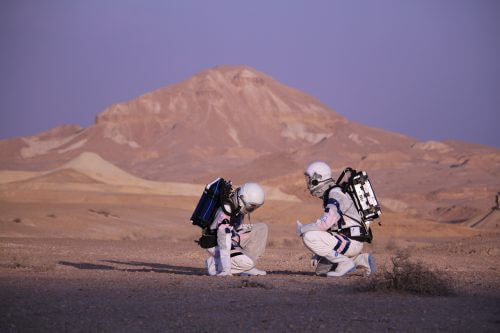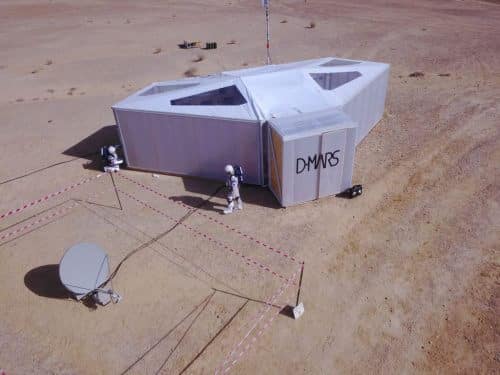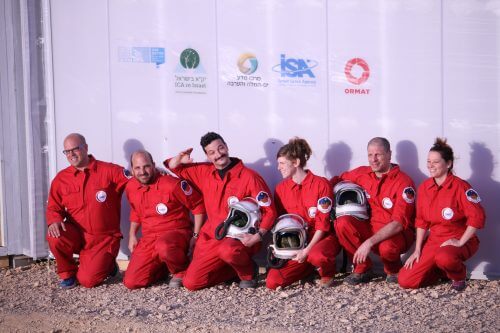Six scientists and experts "landed" a few days ago in a secret and isolated place in the Mitzpe Ramon area to participate in the D-mars Mars imaging project, a simulation that took place for the first time in Israel in collaboration with the Israel Space Agency. The simulation is designed to explore and simulate possible life in the near future on the planet Mars. During the experiment, the participants lived in conditions similar to Mars, were cut off from the world, walked around in space suits and conducted five experiments.

"Space agencies around the world are already busy preparing for the journey to Mars and solving the many technological challenges on the way there," says the Director of the Israel Space Agency at the Ministry of Science, Avi Blasberger. "Among the challenges they are trying to crack are building a spaceship and an engine that can fit the long journey, the effect of cosmic radiation on man, transporting and erecting a structure on the spot, living in a small and isolated group, communicating with the Earth and more. Israel already has a part in the preparations for the journey to Mars by developing technologies to defend against radiation."
The six "Ramonauts" - a combination of Mitzpe Ramon and astronauts - who participated in the mission report that the experiments ended successfully: in the cosmic radiation experiment, the Ramonauts succeeded in proving that cosmic radiation can be easily measured anywhere on the surface of Mars - a critical thing for colonization there, since the radiation on Mars is much higher than The radiation to the earth, because of the thin atmosphere and the lack of the magnetic field.
In the geobiological experiment, pieces of soil were sampled that underwent preliminary analysis in the laboratory inside the habitat, and will later be sent to research laboratories at the Minerva Center at the Weizmann Institute of Science. In the psychological experiment, research questionnaires were collected and sent to universities in Italy for further research. The communication experiment was successful and during a communication failure between the control room and Habitat, the Harmonauts managed to overcome the problem and transmit information through the control room in Austria.

The Harmonauts stayed most of the day in the "Habitat" built especially for the mission, and went out several times in the space suits for the purposes of a scientific mission and for the care of the Habitat. The amount of drinking, walking distances, blood pressure and heart rate were measured throughout the time of the outdoor mission.
The mission was monitored during the day by a team in the control room at the Davidson Institute for Science Education who provided support on science, safety and communication issues, documented the mission and delivered messages to the families of the astronauts - all done with a ten minute delay.
Dr. Hillel Rubinstein, the mission commander summed up the experience on Mars: "A special and exciting experience, an amazing team, even adults can continue to dream about distant stars!".
The mission was a successful first tool test and in the near future more isolation missions are planned with the participation of high school students as part of the "Astronaut School" program supported by the Israel Space Agency in the Ministry of Science at the Dodson Institute for Science Education, and in the future representatives from the general public may be selected. The Austrian Space Forum, the leading body in analog missions in the world, plans to conduct an especially long international simulation at the site in the coming years and later a visitor center will be built at the site and will be open to the general public.
The six "Ranauts" who participated in the project:
Dr. Hillel Rubinstein (40) - Postdoctoral fellow at Ben Gurion University researching missions to Mars and developing a concept for an observational satellite in very low orbit. In addition, also a nature and animal lover. Dr. Rubinstein is the mission commander and is in charge of a satellite communication experiment between Mitzpe Ramon and imaging in Oman.
Dr. Reot Sorek-Abramovich (39) - holder of a doctorate in microbiology and immunology, founder of the Israeli Mars Association and lecturer in astrobiology at the International Space University. She was the mission's science officer and was responsible for three simulation experiments: a search for life research through the collection of soil samples, a feasibility test of XNUMXD printing from local soil, and a psychological experiment on the effect of isolation and stress conditions on the functioning of astronauts.
Prof. Guy Ron (42) - An expert in nuclear physics from the Hebrew University, who researches particle accelerators in different parts of the world, was responsible for the mission on the research on measuring cosmic radiation.

Jacqueline Fay (32) - The director of the music center at Mitzpe Ramon and an astronomy tour guide, she was responsible for documenting the mission and writing a menu for Mars.
the architect Alon Shikar (37) - Has an independent architecture and design practice and is a lecturer at the Technion, specializing in the design of educational buildings. He was responsible for planning and building the habitat and documenting the mission.
Nadav Kushnir (37) - A social work student and tour guide, engaged in guiding educational processes and treatments in the field with individuals and groups, experiential learning lecturer, was the mission's medical officer.
The project operates educational programs in collaboration with the Davidson Institute for Science Education, the Israel Space Agency and the YKA Foundation and works in collaboration with the Dead Sea and Arava Science Center and Mitzpe Ramon Local Council. The center also develops scientific programs and experiments with Ben Gurion University of the Negev, the Hebrew University, the Minerva Center at the Davidson Institute and the Technion. The companies Ormat, Danpal and Alfa Projects contributed to the construction of the building. A space suit was designed by the designer Alon Birvena. The communications for the mission will be provided by the Amos 7 satellite of Halal Communications and Gilat Telecom.
See more on the subject on the science website:
